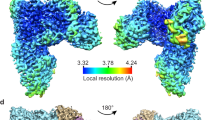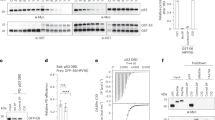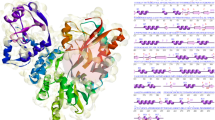Abstract
We have previously demonstrated that ectopic expression of the HPV-18 E6*I protein has an antiproliferative effect in cells derived from HPV-containing cervical tumours. This effect correlated with the ability of E6*I to inhibit the E6-mediated degradation of p53 both in vitro and in vivo and with an increase in p53 transcriptional trans-activation. The observation that the E6*I protein can interact with both full-length HPV-18 E6 and E6-AP proteins in vitro indicated the mechanism by which this activity was mediated. In this study we describe a mutational strategy to attempt to differentiate between the E6-AP and full-length HPV-18 E6 interactions, with respect to the biological function of E6*I. We identify regions of the E6*I protein essential for its interaction with full-length E6 and important for its interaction with E6-AP. We show that a mutant of E6*I which is unable to bind to full-length HPV-18 E6 protein is unable to inhibit the E6-directed degradation of p53 and is also unable to inhibit the proliferation of a cervical tumour-derived cell line. Finally, we show that inhibition of transformed cell growth by E6*I protein correlates with its ability to induce apoptosis in a p53-dependent manner. These results raise the intriguing possibility of using E6*I as a basis for therapeutic intervention in HPV-associated tumours.
This is a preview of subscription content, access via your institution
Access options







Similar content being viewed by others
References
Böhm S, Wilczynski S, Pfister H and Iftner T. . 1993 Int. J. Cancer 55: 791–798.
Butz K, Shahabeddin L, Geisen C, Spitkovsky D, Ullmann A and Hoppe-Seyler F. . 1995 Oncogene 10: 927–936.
Butz K, Geisen C, Ullmann A, Zentgraf H and Hoppe-Seyler F. . 1998 Oncogene 17: 781–787.
Cheng S, Schmidt-Grimminger D-C, Murant T, Broker T and Chow L. . 1995 Genes Dev. 9: 2335–2349.
Clarke A, Purdie C, Harrison D, Morris R, Bird C, Hooper M and Wyllie A. . 1993 Nature 362: 849–852.
Doorbar J, Parton A, Hartley K, Banks L, Crook T, Stanley M and Crawford L. . 1990 Virology 178: 254–262.
Dyson N, Howley P, Munger K and Harlow E. . 1989 Science 243: 934–937.
El-Deiry W, Tokino T, Velculescu V, Levy D, Parsons R, Trent J, Lin D, Mercer W, Kinzler K and Vogelstein B. . 1993 Cell 75: 817–825.
Giaccia A and Kastan M. . 1998 Genes Dev. 12: 2973–2983.
Grassmann K, Rapp B, Maschek H, Petry K and Iftner T. . 1996 J. Virol. 70: 2339–2349.
Huibregtse J, Scheffner M and Howley P. . 1991 EMBO J. 10: 4129–4135.
Lowe S, Ruley E, Jacks T and Houseman D. . 1993 Cell 74: 847–849.
Mantovani F and Banks L. . 1999 Oncogene 18: 3309–3315.
Matlashewski G, Schneider J, Banks L, Jones N, Murray A and Crawford L. . 1987 EMBO J. 6: 1741–1746.
Pim D, Massimi P and Banks L. . 1997 Oncogene 15: 257–264.
Scheffner M, Werness B, Huibregtse J, Levine A and Howley P. . 1990 Cell 63: 1129–1136.
Scheffner M, Huibregtse J, Vierstra R and Howley P. . 1993 Cell 75: 495–505.
Schneider-Gädicke A and Schwarz E. . 1986 EMBO J. 5: 2285–2292.
Schwarz E, Freese U, Gissman L, Mayer W, Roggenbuck B, Stremlau A and zur Hausen H. . 1985 Nature 314: 111–114.
Sherman L and Alloul N. . 1992 Virology 191: 953–959.
Smotkin D and Wettstein F. . 1986 Proc. Nat. Acad. Sci. USA 83: 4680–4684.
Smotkin D, Prokoph H and Wettstein F. . 1989 J. Virol. 63: 1441–1447.
Stacey S, Jordan D, Snijders P, Mackett M, Walboomers J and Arrand J. . 1995 J. Virol. 69: 7023–7031.
Werness B, Levine A and Howley P. . 1990 Science 248: 76–79.
zur Hausen H and Schneider A. . (1987) In: Salzman NP and Howley PM. (eds). The Papillomaviruses. Plenum Publishing Corp.: New York pp. 245–263.
Acknowledgements
We are most grateful to Miranda Thomas for comments on the manuscript. This work was supported in part by a research grant from the Associazione per la Ricerca sul Cancro.
Author information
Authors and Affiliations
Rights and permissions
About this article
Cite this article
Pim, D., Banks, L. HPV-18 E6*I protein modulates the E6-directed degradation of p53 by binding to full-length HPV-18 E6. Oncogene 18, 7403–7408 (1999). https://doi.org/10.1038/sj.onc.1203134
Received:
Revised:
Accepted:
Published:
Issue date:
DOI: https://doi.org/10.1038/sj.onc.1203134
Keywords
This article is cited by
-
A quantitative LumiFluo assay to test inhibitory compounds blocking p53 degradation induced by human papillomavirus oncoprotein E6 in living cells
Scientific Reports (2018)
-
Two less common human microRNAs miR-875 and miR-3144 target a conserved site of E6 oncogene in most high-risk human papillomavirus subtypes
Protein & Cell (2015)
-
Oncogenes and RNA splicing of human tumor viruses
Emerging Microbes & Infections (2014)
-
Human papillomavirus early proteins and apoptosis
Archives of Gynecology and Obstetrics (2013)
-
The HPV-16 E7 oncoprotein is expressed mainly from the unspliced E6/E7 transcript in cervical carcinoma C33-A cells
Archives of Virology (2010)



